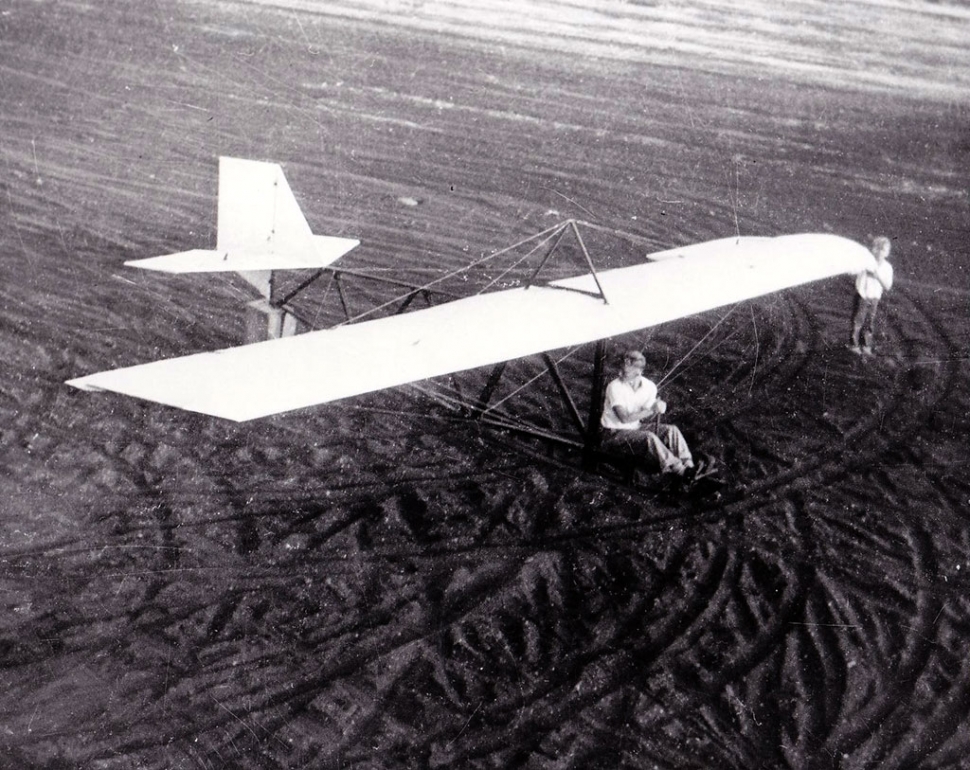|
Those Magnificent Men (and Women) in Their Flying Machines
 Don Shaw, in glider, and Ebbie Wileman at the wing. Photos courtesy Fillmore Historical Museum. By Anonymous — Wednesday, April 21st, 2021
 Barnstormers at "Basolo field" circa 1917.  Basolo field" circa 1946.  Aerial Picture of Fillmore taken by Edith Moore Jarrett, 1928.  Edith Moore Jarrett disembarking in Dublin, September 1956. Courtesy Fillmore History Museum After the First World War, a new phenomenon swept the United States – Barnstormers. Men, who often had learned to fly during the war, traveled the country doing aerobatics, showing the skill of the pilot and the sturdiness of the airplane. Frequently these barnstormers were employed by aircraft manufacturers. That was the case in August of 1919 when the first barnstormer came to Fillmore. Lieut. Arnold Popic was an “aerial demonstrator” for the Zenith Aviation Company. The August 8, 1919 Herald reported that Lt. Popic had arrived the prior Wednesday “floating gracefully over the city” in his open cockpit machine and landed in a field to the west of the Sespe bridge. Two tickets for flights had been sold, one to C. C. Bufkin and one to John Opsahl. Mr. Bufkin took the first flight. Unfortunately, the field had not been prepared properly and the plane struck a deep gully and “its snoot plowed in the opposite bank.” Neither Mr. Bufkin nor Lt. Popic were injured but the plane was damaged to the point it could not fly without repairs. The next week the following ad ran in the paper: Basolo field was a recently mown alfalfa field, located just south of the Bardsdale Bridge. Tickets were $10 for a 10-minute ride and it was reported that 53 tickets were sold for the three days, with the understanding Mr. Bufkin and Mr. Opsahl would get the first flights. For an extra charge, a customer like Homer Cheek, the manager of Rancho Sespe, could take the stunt flight which included flying upside down, along with dips, dives and spins. You could also pay extra to fly higher, up to 3500 feet. It was not just the men who took flight, several women including Edith Moore, age 21, and Hortense Wood, age 14. It is clear that this event and others like it inspired many folks in Fillmore to take up flight – either as pilots, or like Edith Jarrett, becoming world travelers. The news reports didn’t mention whether Betty Elkins, daughter of C. C. Elkins, Jr, and granddaughter of C. C. Elkins, took one of these flights in August of 1919. But according to a story in the May 21st, 2008 issue of the Gazette, Betty became interested in flying at the age of 9 when she won a ride in a Curtiss Jenny by selling magazine subscriptions. In 1929, she married a stunt pilot, Fred Lund, who was World Aerobatic Champion in 1930. Lund taught the former Betty Elkins to fly, and she soon set the woman’s record for doing sixty-seven barrel rolls in twenty-eight minutes. When Lund was killed while competing in a pylon race in Kentucky, Betty took over his appearance contracts and eventually began barnstorming on her own.By the end of the 1930s she was one of the leading stunt pilots in the country. During World War II she served as a WAF transporting airplanes from the West Coast production plants to the East Coast for transport to Europe. Some young people were not content with flying the machines, some wanted to build them too. Two high school students, Don Shaw and Edward “Ebbie” Wileman, built a glider about 1931. No one expected it to fly but fly it did. Unfortunately, it was destroyed in a windstorm. Fillmore’s first airstrip was created in 1928, just east of town and south of the highway, near the current fish hatchery. The area had been swept clean of vegetation by the St. Francis Dam flood. The oil from the Ventura Refinery (later Texaco) was poured on the future runway, covered in sand, disked in and the steps repeated. After compacting by driving heavy trucks over it, the airfield was ready. Many Fillmoreians learned to fly on this strip. This strip was eventually abandoned with the Depression and World War II. Before it went out of service, L. E. Hammond announced the opening of a complete aircraft and engine service. To help advertise his new venture, he flew his own plane under the Bardsdale Bridge, with several inches to spare above and below. Despite not having a formal airfield, airplanes did insist on landing at Fillmore. The story is told of one dark, rainy evening residents hearing the sound of a large plane circling the town. No one is sure how the word got out but within minutes a line of automobiles hurried out of town to a likely flat spot and divided into two rows of bright headlights, one on each side of the impromptu runway, to guide the pilot in. Through the rain a Lockheed Electra made a three-point landing with five terrified passengers. Apparently, the plane had left Bakersfield for Burbank and had gotten lost. After World War II there was renewed interest in having an airport and a new airfield opened near where that first barnstorming plane landed in 1919 and once again became known as Basolo Field, but never received support from the town fathers so lasted only a few years. |
